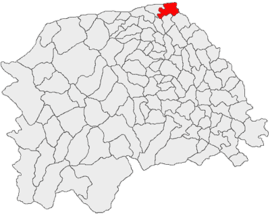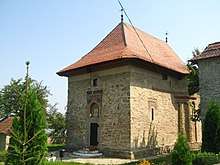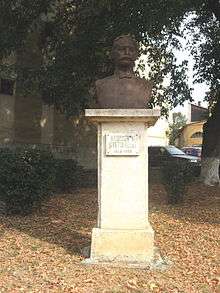Siret
Siret (Romanian pronunciation: [siˈret]; German: Sereth; Polish: Seret; Hungarian: Szeretvásár, Yiddish: סערעט Seret) is a town, municipality and former Latin bishopric in Suceava County, north-eastern Romania. It is situated in the historical region of Bukovina. Siret is the 11th largest urban settlement in the county, with a population of 7,721 inhabitants, according to the 2011 census. It is one of the oldest towns in Romania and was the capital of the principality of Moldavia, in the late 14th century. The town administers two villages: Mănăstioara and Pădureni.
Siret | |
|---|---|
Former Siret town hall | |
 Coat of arms | |
 Location in Suceava County | |
 Siret Location in Romania | |
| Coordinates: 47°57′11″N 26°4′21″E | |
| Country | |
| County | Suceava |
| Government | |
| • Mayor | Adrian Popoiu[1] (PNL) |
| Area | 43.40 km2 (16.76 sq mi) |
| Population (2011)[2] | 7,976 |
| • Density | 180/km2 (480/sq mi) |
| Time zone | EET/EEST (UTC+2/+3) |
| Vehicle reg. | SV |
| Website | siretromania |
Administration and local politics
Town council
The town's current local council has the following political composition, according to the results of the 2016 Romanian local elections:
| Party | Seats | Current Council | |||||||
|---|---|---|---|---|---|---|---|---|---|
| National Liberal Party (PNL) | 7 | ||||||||
| Social Democratic Party (PSD) | 5 | ||||||||
| Independents | 2 | ||||||||
| Ecologist Party (PER) | 1 | ||||||||
Geography
The town of Siret is located at the north-eastern limit of Suceava County, 2 kilometres (1 mile) from the border with Ukraine, being one of the main border passing points in the north of the country, having both a road border post and a rail connection.
The rail is on a standard gauge on the Romanian side and continues as a Russian-style broad gauge into Ukraine. Siret (actually the nearby border passing point called Vicșani – Vadul Siret) is one of the few places in Romania which provides a gauge change equipment, allowing transportation without transfer.
Siret is situated at the half distance between Chernivtsi and Suceava, on the right banks of Siret River. The European route E85 crosses the city.
History

During the period 1211–1225, on a hill near Siret a fortress was built by the Teutonic Knights. The town and the Teutonic castle were destroyed by the Tatars in 1241. The first document of Siret dates back to 1339, according to some historical sources. The town was the capital of the former principality of Moldavia, in the late 14th century.
The Russian imperial Army occupied the town in 1770, and, as a consequence, an epidemic of cholera broke out. Together with the rest of Bukovina, Siret was under the imperial rule of the Habsburg Monarchy (later Austria-Hungary) from 1775 to 1918.
During World War II, Siret was captured on 3 April 1944 by Soviet troops of the 1st Ukrainian Front in the course of the Dnieper–Carpathian Offensive.
Religions
Given the 14th century decline of the Byzantine empire as Orthodox regional superpower-ally and Latin mendicant orders missions since the 13th century, prince Bogdan I of Moldavia obtained virtual independence in 1359 as founding voivode (autonomous prince), seeking aid and protection from Poland, welcomed Latin missionaries, Francescans (founding a monastery at Siret in 1340) and Dominicans. His son and indirect successor Lațcu of Moldavia (1365-1373) promised Rome his and the people's conversion to Catholicism and asked Pope Urban V to send missionaries and erect a Latin diocese in his principality's capital, Siret, which happened in 1371, initially directly subject to the Holy See until 1412 when it was made suffragan of the Archbishopric of Lviv (Lwów in Polish; now in Ukraine). This Roman Catholic Diocese of Siret started to decline in 1388 when prince Petru of Moldavia transferred the Moldavian voivode's capital from Siret to Suceava, and was effectively suppressed, but from circa 1418, the Holy See erected another Moldavian bishopric, the Diocese of Baia, which inherited its territory (1434?).
There was a Jewish community by the mid-16th century. Zionist activity began at the turn of the 20th century, a time when most of the local Jews worked in commerce. From 1912 to 1918, the mayor was Jewish and the town council included Jews. During World War I, Jews fled in advance of the Imperial Russian Army, and found their property destroyed when they returned. After the union of Bukovina with Romania, the new authorities revoked licenses for Jewish members of the free professions and removed Jewish officials from their posts. In 1930, there were 2,121 Jews or 14% of the town's population. In 1936, Baruch Hager of the Vizhnitz dynasty was named rabbi and opened a yeshiva. During the interwar period, there was activity by Zionist youth movements. On June 20, 1941, just before Romania's entry into World War II, the authorities of the Ion Antonescu regime forced the Jews of Siret to march to Dornești before transporting them to Craiova and Calafat and finally Transnistria (see The Holocaust in Romania). Soviet troops liberated 460 Siret Jews there in 1944; 400 of them subsequently left for Palestine.[3]
Today, most of the population is Romanian Orthodox, with Roman Catholic, Pentecostal, Greek-Catholic and Christian Evangelical minorities.
Demographics
| Historical population | ||
|---|---|---|
| Year | Pop. | ±% |
| 1910 | 7,948 | — |
| 1930 | 9,905 | +24.6% |
| 1948 | 8,058 | −18.6% |
| 1956 | 5,664 | −29.7% |
| 1966 | 8,018 | +41.6% |
| 1977 | 8,264 | +3.1% |
| 1992 | 10,071 | +21.9% |
| 2002 | 9,329 | −7.4% |
| 2011 | 7,721 | −17.2% |
| 2016 | 9,720 | +25.9% |
| Source: Austrian and Romanian census data and/or official estimates | ||
Siret reached its peak population in 1992, when more than 10,000 people were living within the town limits. In 2016, Siret had a population of c. 10,000 inhabitants.[4]
According to the 2011 census data, 7,721 inhabitants lived in Siret, a decrease from the figure recorded at the 2002 census, when the town had a population of 9,329 inhabitants. In 2011, of the total population, 95.85% were ethnic Romanians, 2.55% Ukrainians, 0.72% Poles, 0.42% Germans (Bukovina Germans), 0.28% Russians (Lipovans).
Siret is the eleventh most populated urban locality in Suceava County.
Notable natives
- Yitzhak Artzi - Israeli politician
- Elisabeth Axmann - Romanian-German poet
- Leo Katz (1892-1954) - writer and journalist[5]
- Elisabeta Lipă - Romanian rower
- Victorin Ursache - Romanian archbishop
International relations
Siret is a member of the Douzelage, a unique town twinning association of 24 towns across the European Union. This active program began in 1991, and regular events, such as a produce market from each of the other countries and festivals.[6][7] Discussions regarding membership are also in hand with three additional towns (Agros in Cyprus, Škofja Loka in Slovenia, and Tryavna in Bulgaria).
Twin towns – sister cities
Siret is twinned with:
|
Gallery
 Statue of Margareta Mușat in downtown Siret
Statue of Margareta Mușat in downtown Siret Petru Mușat High School
Petru Mușat High School The Chronic Diseases Hospital
The Chronic Diseases Hospital The Old Train Station
The Old Train Station Iacob Zadik House
Iacob Zadik House Simion Florea Marian House
Simion Florea Marian House Simion Florea Marian Statue
Simion Florea Marian Statue Teodor V. Ștefanelli Statue
Teodor V. Ștefanelli Statue The Roman Catholic Church
The Roman Catholic Church The Greek Catholic Church
The Greek Catholic Church The Old Evangelical Church
The Old Evangelical Church The Jewish Temple
The Jewish Temple
References
- "Results of the 2016 local elections". Central Electoral Bureau. Retrieved 5 April 2020.
- "Populaţia stabilă pe judeţe, municipii, oraşe şi localităti componenete la RPL_2011" (in Romanian). National Institute of Statistics. Retrieved 4 February 2014.
- Shmuel Spector, Geoffrey Wigoder (eds.), The Encyclopedia of Jewish Life Before and During the Holocaust: Seredina-Buda-Z, p. 1186-87. NYU Press, 2001, ISBN 978-081-4793-78-7
- "Populaţia României pe localitati la 1 ianuarie 2016" (in Romanian). INSSE. 6 June 2016. Retrieved 27 October 2017.
- Match, Richard (July 20, 1947). "Trouble in Sereth". Review of Seedtime by Leo Katz. The New York Times. Retrieved July 20, 2019.
- "Douzelage.org: Home". www.douzelage.org. Archived from the original on February 17, 2010. Retrieved October 21, 2009.
- "Douzelage.org: Member Towns". www.douzelage.org. Archived from the original on April 6, 2009. Retrieved October 21, 2009.
- "Partnerstwo Samorządów Siłą Europy". Europa Miast (in Polish). Retrieved 2013-08-13.
External links
| Wikimedia Commons has media related to Siret. |
- (in Romanian) Siret Town Hall official site
- (in Romanian) Siret unofficial site
- (in Romanian) Laţcu Vodă High School, Siret
- (in Romanian) The Chronic Diseases Hospital of Siret
- (in Romanian) Suceava County site - Siret web page
- (in Romanian) Photo Gallery - Old photos of Siret
